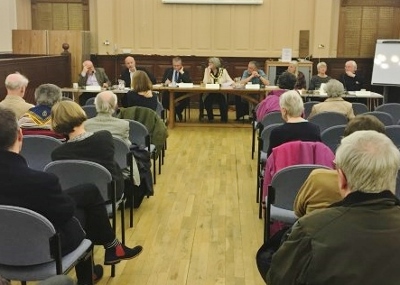Thame residents quiz councillors in open forum
On 29/03/2019 At 8:49 pm
Category : Missed a ThameNews story?, More News, Thame news
Responses : No Comments
A less-than full house, compared to previous years, gathered at Thame’s anual Town Meeting on Tuesday, March 26, 2019, to ask questions of a panel of town, district and a county councillor, chaired by the Mayor of Thame, Ann Midwinter, subjects including the Cattle Market, supermarkets, parking, a dangerous junction and climate change.

In the open forum, resident, Colin Bignall, asked if the people of Thame would be able to have a say about what is provided on the current Cattle Market site, once it moves to its new site. The Town Clerk, Graham Hunt, replied that the town council wanted to make sure that the site was used ‘sensibly’ for Thame, and that the aspiration was for ‘mixed use’ including for community use.
“We are constantly asking SODC (Ed. who own the site) what their plans are, and us giving our views. The latest is the Head of Properties at SODC telling us that they are waiting for solid news about the Cattle Market’s move before talking to us.”
Cllr Nigel Champken Woods said that the Catttle Market was the only long-term parking space in Thame, and that the council would be doing all it could not to lose it.
County Cllr Nick Carter said that SODC had a legal obligation to make the most economic use of the site and would decide what would bring in ‘the most revenue’ for the community. The Mayor of Thame, Ann Midwinter, added: “I am sure the public’s opinion will be sought.”
Helena Richards, long-term member of Cmag (Cattle Market Action Group) said that, reading the district council’s Local Plan: “There is no mention of the Cattle Market site!” The Clerk assured her that he would pass her concerns on. The Mayor thanked Mrs Richards for what she and Cmag do for the town.
Cllr Bob Austin added: “The Cattle Market lease runs out in 2021. One hopes that the relevant officers (at SODC) talk to us because time is running out to get sensible in-put into it.”
Supermarket
Resident Paul Bradley raised the issue of a Supermarket on the Cattle Market site. The Clerk said that there was some idea of what should happen on the site, following a retail analysis from Carter Jonas four years ago (see LINK) which identified a ‘deep discounter’ as the least-worst option for the site, and a Tesco or Sainsbury’s as the worse. A mix of community use, retail and parking was the best option, the analysis had concluded.
Parking
County Cllr Nick Carter responded to a question about illegal parking in the town, describing it as ‘a plague’ for everyone. Currently illegal parking was a matter for the police, he explained, but that they had ‘other priorities. For the future he said, conversations were taking place about taking the responsibility away from the police which would need a legal procedure to take offences away from being criminal to a civil offence, thereby devolving responsibility to SODC. ‘Decriminalising’ parking would require discussions with Thame Town Council, he added.
The Clerk explained that the main options would be; to install parking machines to control the two-hour parking areas; to Decriminalise all parking in the town, which would mean Thame Town Council needing to have its own parking policy; if SODC took over parking, they would see it as a revenue stream; an increase in the Police part of the Precept so that they could deal with illegal parking. None of these options, suggested the Clerk, were likely to happen within two years.
Cllr Nigel Champken Woods said that Decriminalisation was within the RADA of SODC, and that there is money set aside to look at them taking over parking.
Pavements
A new, Oxford Road resident described pavements on the south side of the High Street as ‘disgraceful’ and ‘really atrocious’. Cllr Nick Carter replied that, now that the matter had been brought to his attention, he would ask the Highways Department to look at it.
The Mayor then read out questions that had been sent in to the council from residents who were unable to attend the Town Meeting in person. The first raised the problem of the flooding of the turning circle at Lord Williams’s Upper School, which has been a problem, the correspondent said, for 35 years.
Cllr Carter said that it was the responsibility of the school itself to take the initiative and level the land.
‘Dangerous’ junction
A member of the audience asked if it would be possible to build a round-about at the junction of Thame Park Road and Wenman Road, which they suggested was dangerous because it was difficult to see traffic approaching from the left, from Thame Park Road if one was wanting to turn right into town. Cllr Carter explained that the junction had been altered four or five years-ago deliberately to discourage traffic going through the town centre from Thame Park Road. “It has fulfilled its purpose,” he said, and that in his view, the junction worked fine. He did however, agree to get Highways to look at it.
Burial space
In response to a question about the fence between the new section of burial ground at St Mary’s Church that was part of the old allotments, the Clerk said that a hedge had been planted and that the new area had provided 15 more years of burial space. Although the town council has no legal resonsibility to provide burial space, he said, the council was looking elsewhere for additional burial space for the future, in the Thame Neighbourhood Plan.
Climate Crisis
The final question from the floor was whether the town council intended to follow the example of many local authorities, including Oxford City Council, who have declared a ‘Climate Emergency‘. The panel explained that the Green Living Plan would continue to develop its policies and that the council had taken several steps towards being more sustainable, including carrying out an ‘energy audit’ of the town hall and had gone ‘paperless’ regarding minutes and reports distributed to councillors before meetings, where tablets were used to access digital papers.
The questioner said that she hoped the council would look further at aspects of its own functioning, including its energy suppliers and where it invests the community’s funds.

